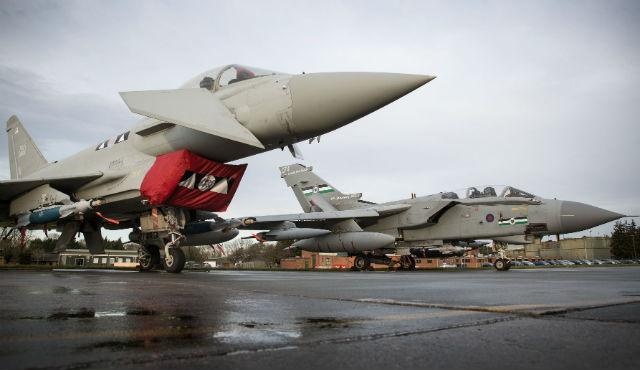A squadron-strength detachment of Royal Air Force Eurofighter Typhoons has arrived at Nellis AFB in Nevada, ahead of their participation in a three-week Red Flag-series exercise to be conducted from late this month.
Ten Typhoons made the journey from RAF Lossiemouth in Scotland, with their deployment supported by Airbus A330 Voyager tanker/transports from the service’s 10 and 101 squadrons.
Pilots from its 1 Sqn will now begin detailed preparations for the exercise, “which includes familiarising themselves with local air traffic control procedures and flying with US Air Force units over the Nellis training range”, the RAF says.

Crown Copyright
A key element of the UK contribution during the Red Flag 15-1 manoeuvres will be to assess the maturity of a new package of enhancements for the Typhoon incorporated in the P1Eb operating standard. Work will include performing so-called “swing-role” operations, where individual aircraft will be required to conduct air-to-air and air-to-surface tasks during a single sortie.
The RAF plans for its deployed aircraft to release 20 Raytheon Systems Paveway IV precision-guided bombs during the course of the air warfare exercise. Up to six of the 226kg (500lb)-class weapons can be carried by the Typhoon.
Participation in Red Flag 15-1 from 26 January will follow an RAF Typhoon deployment to the event 12 months ago. Involving pilots from its 6 and 1 squadrons, this was focused on using the Eurofighter in its air-to-air role.
Separately, the RAF has established its latest unit to fly the Typhoon, by transferring on 9 January the 2 Sqn badge from one operating the Panavia Tornado GR4. To be based at Lossiemouth, the reformed 2 Sqn is the fifth frontline squadron to receive the type, joining 1, 3, 6 and 11.

Crown Copyright
Now rebadged as 12 Sqn, the Marham-based Tornado unit was late last year given a one-year operational extension, until March 2016. It is one of three frontline RAF squadrons still flying the type, including 9 and 31.
Source: Flight International



















